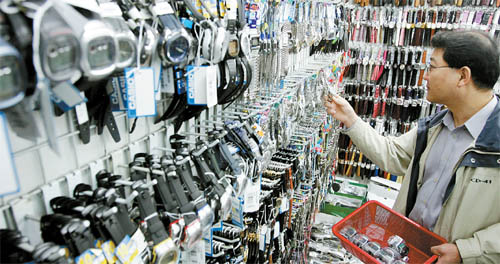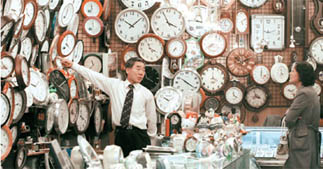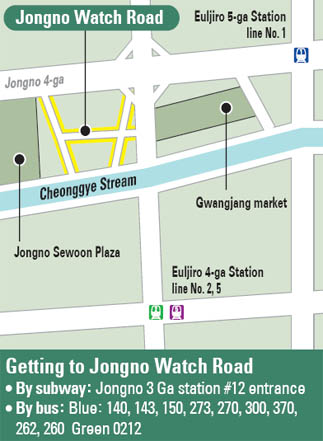Business slowing on Watch Road as time ticks by

A customer picks wristwatches to purchase at one of the stores along Watch Road. There are some 2,000 stores selling a large variety of watches along the street in Jongno 4-ga. By Jeon Min-kyu
This is a trend that Jung Kwun-chun, chairman of the Jongno 4-ga stores association and owner of the watch wholesale shop TM Watch, has learned from selling wristwatches there since 1979, a job he got immediately after graduating from high school.
He works on a street noted for its cluster of over 2,000 watch shops, in Jongno 4-ga.
“Nowadays sales of yellow watches are on the rise,” Jung said. “This means that the market is entering a recession.”
The street dubbed “Watch Road” is located right next to the Gwangjang Market in downtown Seoul. In narrow alleys behind Shinhan Bank, small shops - some without roofs - are crowded together, displaying row after row of glittering wristwatches behind glass panels. In some of the shops huge colorfully decorated clocks instead of watches, hang on the walls. It’s nearly impossible here to lose track of time. The buildings where the shops occupy the first floors are no higher than three stories. The street was not crowded one recent afternoon as the sun was setting.
Lim Seung-yeon, 37, was searching for a wristwatch. He said he was a long-time customer of the street. “Ever since I was a young student this was the only place I would come to buy a watch,” Lim said. He says that nearly every watch imaginable is found at Jongno 4-ga and they can be had at bargain prices. There’s even a limited edition of Longines Lindberg Hour Angle in a square wooden box with pilot gear that retails for less than 3 million won [$2,325]. According to Jung of TM Watch, customers can get discounts of 10 to 40 percent. The stores even accept credit cards. “You can’t do business without those anymore,” Jung added.
“The products here are sold at lower prices than at department stores because overhead is cut out,” Jung said. “Here we don’t spend too much on display or on packaging. If you are a practical consumer, this is the place.” He said because many of the stores invest little on displays, employees and lighting, some customers believe the models aren’t the same as those found in department stores. “They think it’s an entirely different model because the lighting on the watches is different than at department stores,” Jung said. But the watches are the same, he says. In addition to selling watches, the street is noted for polishing and watch repair services.
“Other than electronic watches, which require special wiring, most types of mechanical watches can be fixed here at an affordable price,” Jung said. “I would say 98 percent of watches are reparable.”
He said the strength of this neighborhood is its one-stop service. Any customer who wishes to polish and repair an aging watch can have it done in a single day. The street in recent years, however, hasn’t been what it used to be. Kim Gwan-soo, 62, who began selling watches in the street 45 years ago at the age of 18, recalled the heydays when the street was bustling with customers. “There were many film actors and celebrities who came here to purchase the latest watch,” Kim recalled. One of the frequent visitors was the film actor Kim Han-seop also known as “Twist Kim,” who was popular in the 60s and 70s. “When business was good we would open our stores early in the morning and close after midnight,” Kim said. “People came and went like the tide.”

A store owner on Watch Road attends to a customer. The street is noted for watches and clocks since the 1950s and flourished until the late 1990s. By Jeon Min-kyu
The street was first formed sometime in the 1950s. Kim says the shops first started businesses by selling secondhand foreign-made wristwatches on the side of the road. “Before the government sealed up the Cheonggye Stream, there were many restaurants and yojeong (gisaeng bars) on the street,” Kim said. “With so many people coming and going, merchants started selling all sorts of antiques and items, including wristwatches collected from U.S. military bases,” Kim recalled.
With shops popping up here and there, they soon formed a street of watch shops. The watch sellers said the market started to take its current form in the 1970s. The market flourished in the 80s when electronic watches like Casio gained wide national popularity and was still going strong until the late 90s.
“The industry was heavily struck by the financial turmoil. Since then business hasn’t picked up,” said Jung. The biggest contributor to the decline is modern digital technology. Digital mobile phones, which also tell time, have replaced wristwatches. “People are reluctant to buy wristwatches because they can tell time from their mobile phone so what’s the need of a wristwatch?” Jung said.
The watch seller added that only the rich buy watches as wedding gifts. In Korea, it has been a long-standing custom for a future husband and wife to buy each other wristwatches. In the 70s and 80s, Rolex was the most popular brand.
“The most popular wedding gift wristwatches were those in the 200,000 won to 500,000 won range, which were affordable for the middle income class,” Jung said. “With middle incomes disappearing, there’s hardly anyone in that class buying watches as wedding gifts.”

“Customers want fashion brand watches like Gucci and Armani,” Kim said. It’s hard for Watch Street to compete in the fashion game.
But there’s hope. “There are people in their 20s and 30s who search for rare watches,” Jung said. “There are those who are deeply interested in the frames, the details and even the straps.”
It is such young devotees who keep the street alive. To survive against the growing presence of fashion watches, the street needs to focus on what it does best, he says. “We are specialized in polishing and fixing rare old watches,” Jung said. “And we need to refocus on that specialty.”
By Lee Ho-jeong Staff Reporter [ojlee82@joongang.co.kr]
Glimpse of Business in Seoul list
Business booms before Buddha’s birthday
‘Perm factory’ streets slowly ebbing
Seoul’s Bangsan wallpaper area weathers crisis
Weaker won creates glasses spectacle
Sadang brims over with top furniture bargains
Rare stamps and old-world charm
Something alluring stays on art street
Cures galore grace ‘Drugstore Street’
Itaewon’s changing face: global food
Birds of many feathers flock to midcity street
Leather and furs galore at Dongdaemun’s Kwang-Hee mall
Flea market is awash in used goods
A street where film cameras thrive
Traditional Korean rice cakes take a pounding in the streets of Nakwon
Meat market is not for fainthearted
Cookies helped create street known for printing
Seafood market is largest in the nation
This tasty corner of Bangsan Market stirs up Seoul’s do-it-yourself bakers
Need a lawyer? Check out Seocho-dong
Light shop owners swell with pride over products
Glitter and gold fill the streets of the Jongno district
Past textbook haven specializes to survive
What every bride needs: Dress St.
A market where agriculture still rules the day
Fall flowers in fashion at the Yangjae Market
Tool complex in Guro is a Mr. Fix It paradise
Bikers’ dream roars along in Seoul
Yongsan Market offers a sea of digital gadgets
An uncertain future faces Dokebi
An uncertain future faces Dokebi
Korea’s new face of plastic surgery
One stop pet shopping builds on ’60s tradition
Antique market thrives in city’s lesser-known Dapsimni district
From guitar picks to pianos, Nakwon sells it all
Used car dealers say not to worry
A fashion mecca thrives in Seoul










with the Korea JoongAng Daily
To write comments, please log in to one of the accounts.
Standards Board Policy (0/250자)